
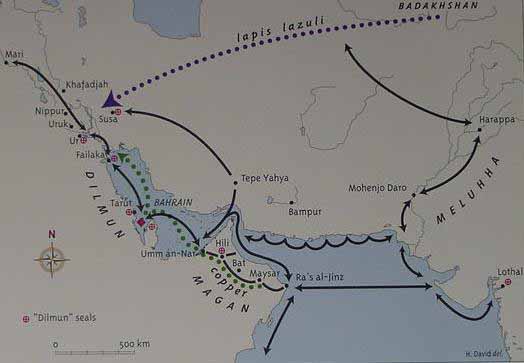


Dilmun is associated with ancient sites on the islands of Bahrain in the Persian Gulf, the Cradle of Civilization.
Dilmun (sometimes transliterated Telmun) is associated with ancient sites on the islands of Bahrain in the Persian Gulf. Because of its location along the sea trade routes linking Mesopotamia with the Indus Valley Civilization, Dilmun developed in the Bronze Age, from ca. 3000 BC, into one of the greatest entrepots of trade of the ancient world.
There is both literary and archaeological evidence for the trade between Mesopotamia and the Indus Valley (probably correctly identified with the land called Meluhha in Akkadian). Impressions of clay seals from the Indus Valley city of Harappa were evidently used to seal bundles of merchandise, as clay seal impressions with cord or sack marks on the reverse side testify.
A number of these Indus Valley seals have turned up at Ur and other Mesopotamian sites. "Persian Gulf" types of circular stamped rather than rolled seals, known from Dilmun, that appear at Lothal in Gujarat, India, and Faylahkah, as well as in Mesopotamia, are convincing corroboration of the long-distance sea trade. What the commerce consisted of is less sure: timber and precious woods, ivory, lapis lazuli, gold, and luxury goods such as carnelian and glazed stone beads, pearls from the Persian Gulf, shell and bone inlays, were among the goods sent to Mesopotamia in exchange for silver, tin, woolen textiles, olive oil and grains. Copper ingots, certainly, bitumen, which occurred naturally in Mesopotamia, may have been exchanged for cotton textiles and domestic fowl, major products of the Indus region that are not native to Mesopotamia - all these have been instanced.
Mesopotamian trade documents, lists of goods, and official inscriptions mentioning Meluhha supplement Harappan seals and archaeological finds. Literary references to Meluhhan trade date from the Akkadian, the Third Dynasty of Ur, and Isin - Larsa Periods (ca. 2350 - 1800 BC), but the trade probably started in the Early Dynastic Period (ca. 2600 BC). Some Meluhhan vessels may have sailed directly to Mesopotamian ports, but by the Isin - Larsa Period, Dilmun monopolized the trade. By the subsequent Old Babylonian period, trade between the two cultures evidently had ceased entirely.
The Bahrain National Museum assesses that its "Golden Age" lasted ca. 2200 - 1600 BC. Its decline dates from the time the Indus Valley civilization suddenly and mysteriously collapsed, in the middle of the 2nd millennium BC. This would of course have stripped Dilmun of its importance as a trading center between Mesopotamia and India. The decay of the great sea trade with the east may have affected the power shift northwards observed in Mesopotamia itself.
Evidence about Neolithic human cultures in Dilmun comes from flint tools and weapons. From later periods, cuneiform tablets, cylinder seals, pottery and even correspondence between rulers throw light on Dilmun. Written records mentioning the archipelago exist in Sumerian, Akkadian, Persian, Greek, and Latin sources.
Dilmun, sometimes described as "the place where the sun rises" and "the Land of the Living" is the scene of a Sumerian creation myth and the place where the deified Sumerian hero of the flood, Ziusudra (Utnapishtim), was taken by the gods to live for ever.
There is mention of Dilmun as a vassal of Assyria in the 8th century BC and by about 600 BC, it had been fully incorporated into the Neo-Babylonian Empire. Dilmun then falls into deep eclipse marked by the decline of the copper trade, so long controlled by Dilmun, and the switch to a less important role in the new trade of frankincense and spices. The discovery of an impressive palace at the Ras al Qalah site in Bahrain is promising to increase knowledge of this late period.
Otherwise, there is virtually no information until the passage of Nearchus, the admiral in charge of Alexander the Great's fleet on the return from the Indus Valley. Nearchus kept to the Iranian coast of the Gulf, however, and cannot have stopped at Dilmun. Nearchus established a colony on the island of Falaika off the coast of Kuwait in the late 4th century BC, and explored the Gulf perhaps least as far south as Dilmun/Bahrain.
From the time of Nearchus until the coming of Islam in the 7th century AD Dilmun/Bahrain was known by its Greek name of Tylos. The political history for this period is little known, but Tylos was at one point part of the Seleucid Empire, and of Characene and perhaps part of the Parthian Empire. Shapur II annexed it, together with eastern Arabia, into the Persian Sasanian empire in the 4th century.
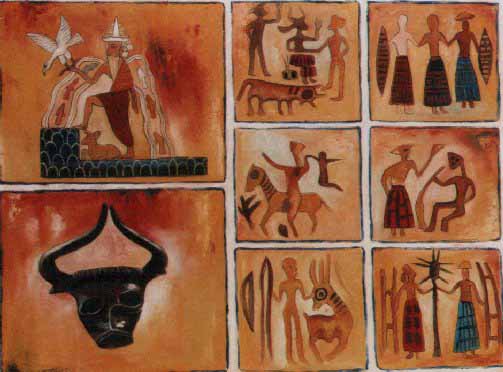
Cylinder Seals
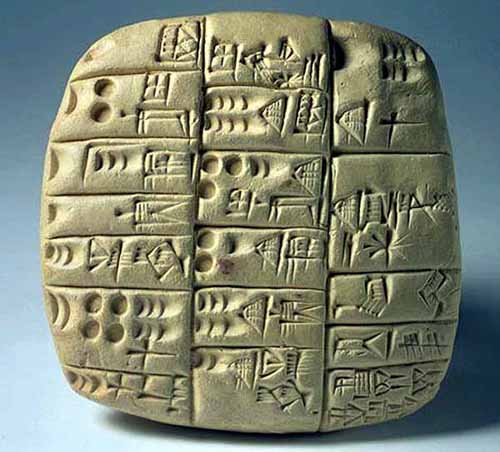
Cuneiform Tablets
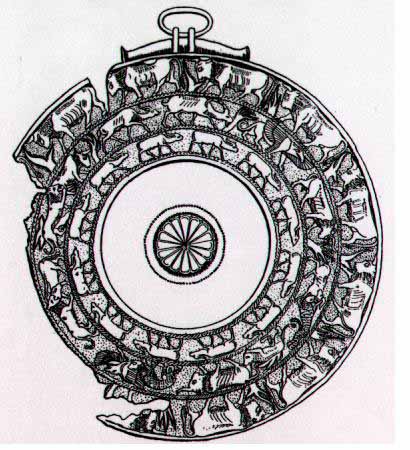
Unlike Egyptian and Mesopotamian tablets and cylinders, the Dilmun legacy has been discovered on circular seals. The primitive forms of images carved on the seal indicate they were used as charms or talisman. Carved on wood, soapstone shells or metal, these images clearly define a complex society. Temples in the center of the agrarian village, towns, city-states, religious, and economic cultural life. All facets of the emergence of an evolutionary society are reflected in the inscriptions about the seals.
Impressions found on pottery and property is a probable usage of the seals. Burying them with the dead was probably to avoid misuse. Tiny fragments found impressed, suggest identifying property. Clearly there was an intrinsic value; each seal tells a story, has an identity.
Seals depict Enki, Sumerian God of wisdom and sweet water. Gilgamesh as a massive and heroic figure, the 'Bull of Heaven' hat. Ladies of the mountains 'Inanas' servants wearing her triangle signs depicting space for her power. 'Nana' is the moon god who was also named 'sin'. Symbol was the bull of heaven head. Inana, goddess of immortality.
From the dreams of Gilgamesh, to the philosophy of life. Seals depicting a harmonious life with nature and god are painted here in the colors and form I hope you enjoy. The colors naturally excite and stimulate, often sexually. Indisputably the ancient myths of immortality and resurrection influenced Dilmun beliefs and are abundantly supported in the seal designs, represented by gods of the sun and moon.
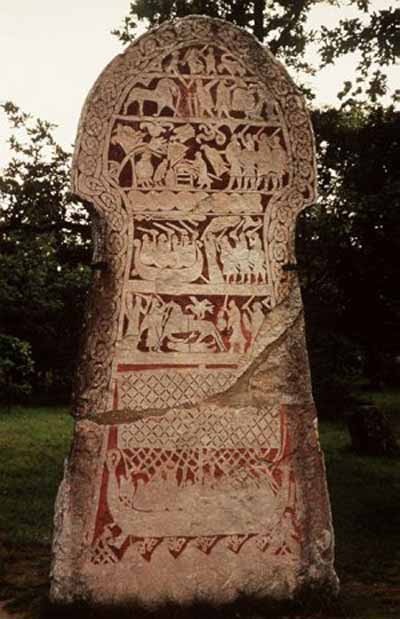
The Mesopotamian texts described Tilmun as situated at the 'mouth' of two bodies of water. The Sinai peninsula, shaped as an inverted triangle indeed begins where the Red Sea separates into two arms - the gulf of Suez on the west, and the Gulf of Elat (Gulf of Aqaba) on the east.
The texts spoke of mountainous Tilmun. The Sinai peninsula is indeed made up of a high mountainous southern part, a mountainous central plateau, and a northern plain (surrounded by mountains), which levels off via sandy hills to the Mediterranean coastline. Sargon of Akkad claimed that he reached as 'washed his weapons' in the Mediterranean; 'the sea lands' - the lands along the Mediterranean coast - 'three times I encircled; Tilmun my hand captured'. Sargon II, king of Assyria in the eighth century BC, asserted that he had conquered the area stretching 'from Bit-Yahkin on the shore of the salt Sea as far as the border of Tilmun'. The name 'Salt Sea' has survived to this day as a Hebrew name for the Dead Sea - another confirmation that Tilmun lay in proximity to the Dead Sea.
The cradle of civilization is sometimes referenced by the name Dilmun, or Tilmun. Here, it was said, the god Ea and his wife were placed to institute 'a sinless age of complete happiness'.
Here too animals lived in peace and harmony, man had no rival and the god Enlil `in one tongue gave praise'. It is also described as a pure, clean and `bright' `abode of the immortals' where death, disease and sorrow are unknown and some mortals have been given `life like a god', words reminiscent of the Airyana Vaejah, the realm of the immortals in Iranian myth and legend, and the Eden of Hebraic tradition
Although Dilmun is equated by most scholars with the island of Bahrain in the Persian Gulf, there is evidence to suggest that a much earlier mythical Dilmun was located in a mountainous region beyond the plains of Sumer.
But where exactly was it located Mesopotamian inscriptions do not say; however, the Zoroastrian Bundahishn text and the Christian records of Arbela in Iraqi Kurdistan both refer to a location named Dilamƒn as having existed around the head waters of the Tigris, south-west of Lake Van - the very area in which the biblical Eden is said to have been located.
Furthermore, Ea (the Akkadian Enki) was said to have presided over the concourse of Mesopotamia's two greatest rivers - the Tigris and Euphrates - which are shown in depictions as flowing from each of his shoulders.
This would have undoubtedly have meant that the head-waters, or sources, of these rivers would have been looked upon as sacred to Ea by the cultures of Mesopotamia's Fertile Crescent.
- Zecharia Sitchin The Stairway to Heaven
Dilmun was allegedly a magical land, the birthplace of the gods and the place where the arts of civilization where said first to have been transmitted to men. It was the subject of many legends told by the Sumerians, the people of southern Iraq; it was famed as a land where death and disease were unknown and men and animals lived at peace together.
It was the home of the Sumerian king who was the origin of the myth of Noah, the immortal survivor of the Great Flood, a story retold in the Qu'ran and the Bible.
The first great hero of world literature, Gilgamesh the king of Uruk, journeyed to Dilmun in search of the secret of eternal youth.
He found it deep in the waters of the Persian Gulf, off Bahrain, but lost it when the flower which restored the youth of those who sought it, was stolen by a snake, lurking in a pool as Gilgamesh returned to his kingdom; this is the reason why the snake sloughs his skin.
Symbolism - All is Myth and Metaphor in our reality
Dilmun was also the center of the most important trade routes of the third and second millennia BC. The most important commodity was copper for which Dilmun was famous and the dates for which Bahrain was always celebrated, from ancient times until the present day.
Because Dilmun was so sacred a land, there were many temples built there, the impressive remains of which can be seen today. The largest and most splendid temple surviving in Western Asia is at Barbar on Bahrain's northern shore.
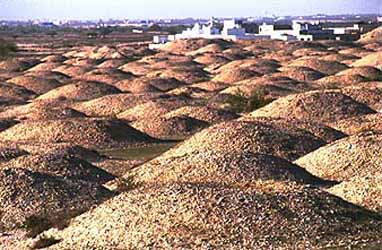
The most famous of all Bahrain's rich archaeological heritage are the 200,000 grave mounds which are a feature of the landscape in the northern half of the island and which, by their size and quality of construction, show how prosperous Bahrain must have been in ancient times.
Dilmun continued to be the most important center of trade in the Gulf region throughout its history.
After the Sumerians, the Babylonians, Assyrians, even the Greeks, settled on the islands, because of their strategic importance in the movement of merchandise, north and south, east and west, by sea and by the land routes to which the seas gave access.
The records of their diplomatic relations with the kings of Dilmun, some of whose names are known from the records, testify to the importance of the islands throughout antiquity.
All left evidence of their presence, preserved today in the Bahrain National Museum and in the immense archaeological sites in which Bahrain is particularly rich.
Bahrain is an open-air treasure house of the past, a unique heritage from the earliest times when men first began to keep records of their hopes, fears and achievements.
It is the contemporary of ancient Egypt with Sumer and the peoples who succeeded them, of the great cities of the Indus Valley.
Formative Dilmun (3200 - 2200 BC):
It is in this period that the earliest mention of name "Dilmun" occurs in Mesopotamian inscriptions. New civilizations had emerged. Cylinder seals from Dilmun were found which were imprinted with tales of the merchants' everyday life of the time.
These discoveries confirmed that trading existed as early as the end of the fourth millennium between Mesopotamia, Dilmun (Bahrain), Magan (Oman), Melukhah and Harapah, the capital cities of the Valley of the Indus, Mesopotamia and the Valley of the Indus. Each country had already reached a high level of civilization at that time.
Boats that set off from the mouth of the Tigris and Euphrates have always stopped here to get fresh supplies in sweet water and vegetables. Cuneiform texts reveal that Dilmun was located a two-days sailing distance from Mesopotamia. Thousands of years ago sailors brought pearls, tortoise shells, coral, palm fronds and coconuts here before sailing off to Magan or the Indus Valley.
On one ancient tablet dated 3100 B.C. Dilmun is described as an "Elysium" where the inhabitants were eternally young and suffered no illnesses, "where the raven did not croak and wolves and lion did not devour their prey."
Early Dilmun (2200 - 1600 BC)
This was the Golden Age of Dilmun during which it reached the zenith of its prosperity and influence. Dilmun controlled the trading routes and built fortified cities, magnificent temples and thousands of burial mounds.
Middle Dilmun (1600 - 1000 BC)
Mesopotamia was under Kassite rule at this time. The correspondence between rulers, cuneiform tablets, cylinder seals and pottery on display is all evidence of interaction between Dilmun and Mesopotamia.
Late Dilmun (1000 - 330 BC)
This period was marked by the decline of the copper trade, so long controlled by Dilmun, and the switch to a less important role in the new flourishing trade of incense and spices. The discovery of the impressive Uperi Palace at Ras al Qalah greatly increased our knowledge of this period.
The collection of Dilmun seals feature prominently in this Hall. The round stamp seals, as opposed to the square seals of neighboring civilizations, are the primary evidence that Dilmun had its own trade relations with the outside world. The exhibits trace the sequence of development of the stamp seals over time as represented by the variety of materials and social and religious subjects portrayed.
When the caliphs of Baghdad founded Basra at the mouth of the Tigris and Euphrates rivers, the Bahraini merchants put out to sea once again and sailed to China, whose routes had been opened by the Omani navigators in the 8th century. Again, Bahrain was used as a port of call, and a large number of Chinese celadons and porcelain have been found here. In the wall of Qal-at Al-Bahrain, archaeologists found a wide variety of Indian, Chinese and Arabian coins with Kufic inscriptions. Some archeologists believe that Bahrain minted its own money from the 10th to the 13th centuries.
Many archaeologists and geographers, who have closely cross-checked all the findings on Bahrain, not only believe that Bahrain was the center of a flourishing civilization, but that the Dilmun empire may have even extended as far as Arabia and Iran.
The name Dilmun is associated with that of Enki, the god of wisdom and water, and the Gilgamesh, King of Uruk in Mesopotamia, whose saga recounts a wonderful mythological tale - a combination of 'A Thousand and One Nights' and images from the Bible.
Archaeologists from the United States, Great Britain and Denmark have been able to put together pieces of this saga, and have concluded that 'The Saga of Gilgamesh,' written long before the Iliad and the Odyssey, is the first-ever written piece of preserved literature.
Thousands of years ago sailors brought pearls, tortoise shells, coral, palm fronds and coconuts here before sailing off to Magan or the Indus Valley.
When the caliphs of Baghdad founded Basra at the mouth of the Tigris and Euphrates rivers, the Bahraini merchants put out to sea once again and sailed to China, whose routes had been opened by the Omani navigators in the 8th century. Again, Bahrain was used as a port of call, and a large number of Chinese celadons and porcelain have been found here. In the wall of Qal-at Al-Bahrain, archaeologists found a wide variety of Indian, Chinese and Arabian coins with Kufic inscriptions.
Some archeologists believe that Bahrain minted its own money from the 10th to the 13th centuries.
Many archaeologists and geographers, who have closely cross-checked all the findings on Bahrain, not only believe that Bahrain was the center of a flourishing civilization, but that the Dilmun empire may have even extended as far as Arabia and Iran.
On one ancient tablet dated 3100 B.C., Dilmun is described as an "Elysium" where the inhabitants were eternally young and suffered no illnesses, "where the raven did not croak and wolves and lion did not devour their prey."
The name Dilmun is associated with that of Enki, the god of wisdom and water, and the Gilgamesh, King of Uruk in Mesopotamia, whose saga recounts a wonderful mythological tale - a combination of 'A Thousand and One Nights' and images from the Bible.
Archaeologists from the United States, Great Britain and Denmark have been able to put together pieces of this saga, and have concluded that 'The Saga of Gilgamesh,' written long before the Iliad and the Odyssey, is the first-ever written piece of preserved literature.
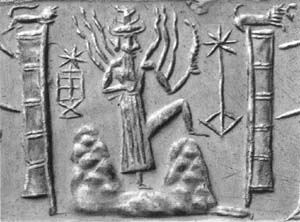
The sun god Shamash rising between Mashu's Twin Peaks.
To the Sumerians, Mashu was a sacred mountain. Its name means "twin" in Akkadian, and thus was it portrayed on Babylonian cylinder seals - a twin-peaked mountain, described by poets as both the seat of the gods, and the underworld .
Mashu is found in three episodes of the Gilgamesh cycle which date between the third and second millennia B.C. Mashu was located in a forest in the "land of the Living", where the names of the famous are written. It is alluded to in the episode Gilgamesh and Humbaba. In this story, Gilgamesh and his friend, Enkidu, travel to the Cedar (or Pine) Forest which is ruled over by a demonic monster named Humbaba.
While their motives for going to the Forest included gaining renown, it is also clear that they wanted the timber it contained. Humbaba, who had been appointed by the god Enlil to guard the Forest, is depicted as a one-eyed giant with the powers of a storm and breath of fire, perhaps the personification of a volcano. It is only with the help of another god, and a magically forged weapon that Gilgamesh triumphs over Humbaba.
But before his battle, Gilgamesh and Enkidu gaze in awe at the mountain called "the mountain of cedars, the dwelling-place of the gods and the throne of Ishtar". They climb onto the mountain, sacrifice cereals to it, and, in response, the mountain sends them puzzling dreams about their futures.
When they begin to fell trees, Humbaba senses their presence and, enraged, fixes his eye of death on the pair. Although Gilgamesh finally defeats the monster, Enkidu eventually weakens and dies from Humbaba's gaze and curse. In addition to its reputation as the "land of the Living", this forest is also a way to the underworld or the other world.
For right after killing Humbaba, Gilgamesh continues in the forest and "uncovered the sacred dwelling of the Anunnaki"--old gods who, like the Greek Titans, had been banished to the underworld . Furthermore, Gilgamesh seems to go into a death-like trance here; and in the same general region, the goddess Ishtar, whom Gilgamesh spurned, threatened to break in the doors of hell and bring up the dead to eat with the living .
Mashu is mentioned directly in the episode "Gilgamesh and the Search for Everlasting Life". This story unfolds after the death of Gilgamesh's friend, Enkidu, a wrenching experience which makes Gilgamesh face his own mortality and go searching for eternal life. It is en route to Utnapishtim, the one mortal to achieve immortality, that Gilgamesh comes to Mashu "the great mountain, which guards the rising and setting sun.
Its twin peaks are as high as the wall of heaven and its roots reach down to the underworld. At its gate the Scorpions stand guard, half man and half dragon; their glory is terrifying; their stare strikes death into men, their shining halo sweeps the mountains that guard the rising sun".
Gilgamesh is able to convince the Scorpion-people to open the gate and let him enter the long tunnel through the mountains. Eventually Gilgamesh emerges from the tunnel into a fantastic Garden of the gods, whose trees bear glittering jewels instead of fruit.
In the view of several scholars, Mashu is also the mountain mentioned in the story that Utnapishtim told Gilgamesh. Utnapishtim, sometimes called the "Sumerian Noah", told Gilgamesh how the gods had become angered with humanity and decided on the Flood as one means to exterminate it. A sympathetic god warned Utnapishtim and told him to build a boat and board it with his family, relatives, craftsmen, and the seed of all living creatures.
After six days of tempest and flood, Utnapishtim's boat grounded on a mountain. He released a dove and a swallow, both of which returned to him. Then he released a raven which did not return; Utnapishtim and his family came down from the mountain. When the disgruntled gods are finally reconciled with the re-emergence of humanity, Utnapishtim and his wife are taken by the god Enlil to live in the blessed place where Gilgamesh found him "in the distance, at the mouth of the rivers".
In his classic study, Armenia in the Bible, father Vahan Inglizian compared the above myths with the Biblical accounts of the Garden of Eden (Gen. 2) and the Flood (Gen.7-8), both of which he sited in eastern Asia Minor. Accepting Lehmann-Haupt's equation of the tunnel through Mashu with the naturally occurring subterranean Tigris tunnel near Bylkalein, Inglizian suggested that Mashu should be sought in the Armenian Taurus mountain range, south of Lake Van. It is in this same southern area, rather than at Mount. Ararat, that many scholars, including Inglizian, place the mountain of Noah (Gen. 8.4).
Inglizian suggested that the phrase "at the mouth of the rivers" describing the blessed land where Utnapishtim lived, should be understood to mean "at the sources of the Tigris and Euphrates rivers".
This heavenly Dilmun of Mesopotamian mythology was later identified with Bahrain on the Persian Gulf.
Dilmun Wikiedia
Reality is a biogenetic experiment based in linear time to study emotions. It is a consciousness hologram which had a beginning and an end that is rapidly approaching. References to reptilians and snakes go to DNA and the spiraling movement of consciousness above and below - faster and slower frequencies of thought and understanding. The patterns of reality follow sacred geometric codes that repeat in cycles called time. All is myth, math and metaphor, the goal to remember who you are and how you came to be in the experiment. It is all preprogrammed in your DNA codes, like time capsules ready to open along with the grid consciousness that creates endless programs through which your soul virtually experiences, learns and records information.
The name Dilmun comes out of the creational energies of the Middle East, the first insert, an entity called Dilmun in time, by many names, most often represented as a winged bird headed, or reptilian being, playing many roles, in all ancient civilizations and creational myths. Always it is the same entity, same energies, same messages, played out in different programs for the viewers to experience as needed.
Dilmun, in various forms as a creator god, is often portrayed carrying a water bucket. This takes us to vessels, containers, blood, sacred bloodline, water, the flow of the collective unconsciousness, and the return to balance in Aquarius.
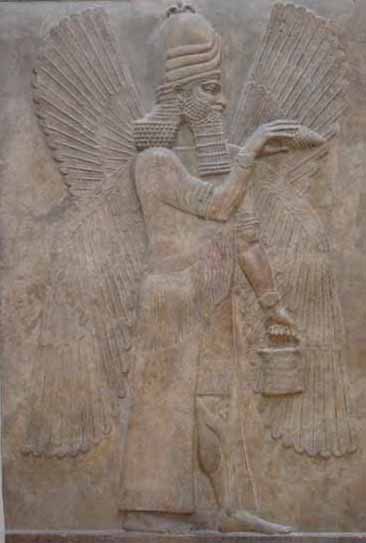
The Sumerian biogenetic experiment begins.
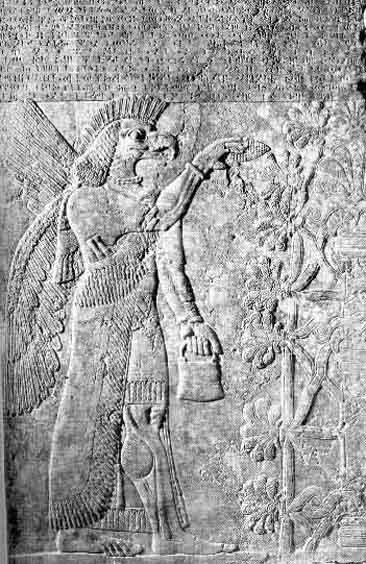
Watering the Tree of Life - Creating a Bloodline
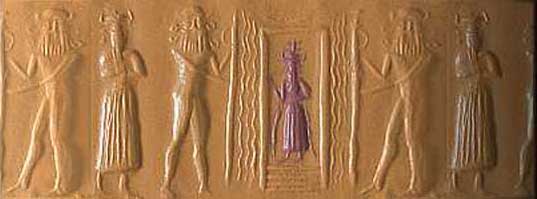
Ea stands in his watery home the Apsu.
Enki walks out of the water to the land attended by his messenger, Isimud
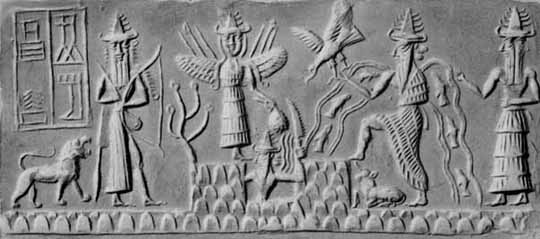
who is readily identifiable by his two faces looking in opposite directions (duality)
Enki stands with the Gods and the Initiate
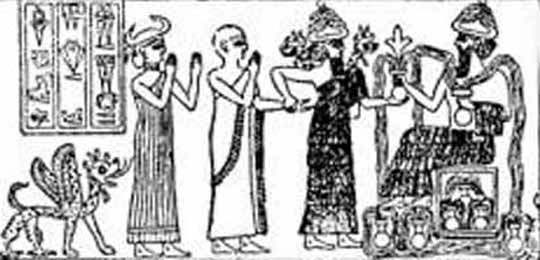
Water of Life flowing into the laboratory glassware indicates alchemical circulations.
The creation of the first human
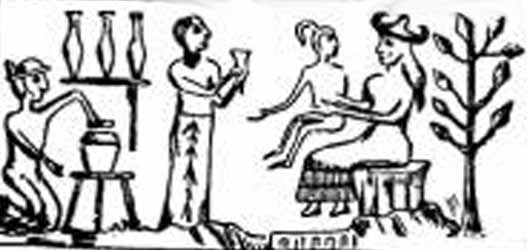
Laboratory vessels symbolize the bloodline and the Tree of Life.
Handing the water/liquid/blood of life
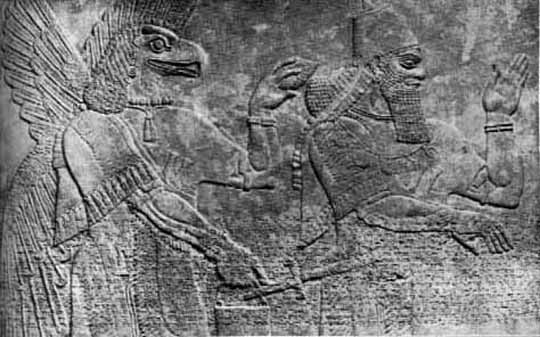
to a bio-genetically engineered human, a hybrid, Persia.
Duality - Yin Yang
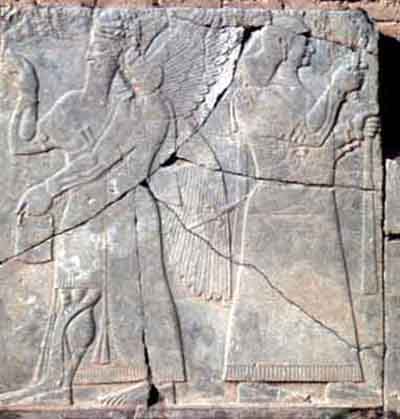
Male-female separation of Twin Soul Aspects